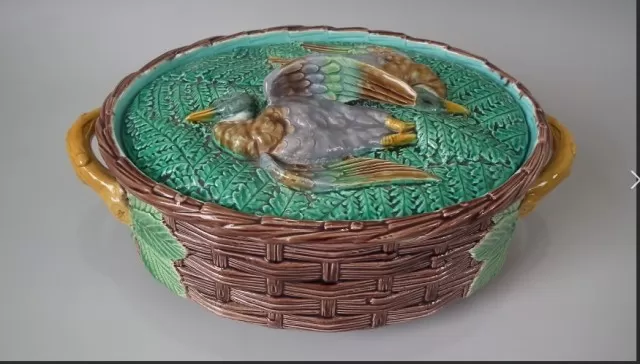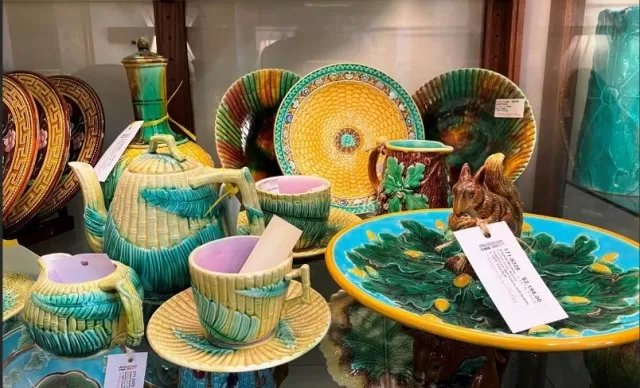Majolica Pottery: An Overview.Majolica pottery, with its roots deeply entwined with nature-inspired designs and motifs, is experiencing a resurgence in popularity within contemporary home decor. The timeless allure of this glazed earthenware, enriched by its artistic connection to the natural world, is captivating the imaginations of modern homeowners and collectors alike.
In a world increasingly driven by mass-produced, homogenized aesthetics, majolica pottery stands as a testament to the enduring appeal of handcrafted, nature-inspired artistry. Its rich history, marked by intricate patterns and vibrant hues, pays homage to the beauty of the natural environment. Each piece tells a story, where elements like lush flora, serene water lilies, graceful birds, and flowing reeds come to life in a harmonious dance of color and form.
Today’s aficionados of majolica pottery are drawn not only to its aesthetic charm but also to its versatility. These pieces seamlessly blend into modern living spaces, enhancing them with an organic, eclectic charm that complements a range of interior styles. Whether displayed as stand-alone centerpieces, adorning dining tables, or gracing mantelpieces, majolica pottery serves as a captivating conversation starter, inviting guests to appreciate its historical significance and the intricate craftsmanship that brings each piece to life.
The revival of majolica pottery in contemporary homes signifies a return to the appreciation of artistry grounded in the natural world, offering A Breath of Fresh Air in an era often dominated by technological innovations. As homeowners seek to infuse their living spaces with character, warmth, and a connection to the natural world, majolica pottery stands as a timeless choice, bridging the past and the present with its enduring allure. In this resurgence, we witness the enduring appeal of an art form that draws inspiration from the beauty and wonder of nature, capturing the hearts of those who seek to bring its charm into their modern lives.
Majolica Pottery: A Vibrant Fusion of Artistry and Craftsmanship

Majolica pottery is a captivating art form characterized by its opulent colors, substantial clay composition, enamel coating, intricate paintwork, and final glazing.
With a storied history, the most sought-after pieces among collectors today are the whimsical creations of Victorian England, adorned with depictions of lush mosses, serene water lilies, graceful ducks, elegant herons, and swaying reeds. Beyond its whimsical designs, this earthenware is renowned for its vivid palette.
Everything from plates to pitchers boasts a radiant spectrum of colors, ranging from lustrous ochers and rich chocolates to a captivating array of greens. Majolica pottery is a testament to the seamless blend of artistry and craftsmanship, making it a cherished treasure for collectors and enthusiasts alike.
Tracing the Origins of Majolica Pottery

The captivating history of majolica pottery dates back to the 15th century, with its earliest creations emerging on the Spanish island of Majorca, which was reputedly once known as Majolica.
Over time, this tin-glazed earthenware found its way to Italy and France, where it took on different names—faenza in Italy and faience in France—paying homage to the renowned Italian city of Faenza, celebrated for its pottery craftsmanship. However, it wasn’t until the 19th century that English artisans embarked on their journey of crafting majolica pottery, incorporating the distinctive patterns and vibrant colors that have become iconic today.
When it comes to assessing the value of majolica pottery, it’s important not to dismiss pieces that have experienced some wear and tear.
Surface blemishes, such as minor cracks, may be deemed acceptable, but structural damage, like missing or broken components, can significantly diminish its worth in the eyes of collectors and enthusiasts.
Tips for Aspiring Majolica Pottery Collectors

Majolica pottery, with its exquisite craftsmanship and historical significance, has a thriving collector’s market, particularly in the United States and Britain.
However, it’s important to be aware that this art form can command quite high prices, especially for pieces produced by renowned manufacturers like Wedgwood, Minton, and George Jones during the period from 1850 to 1900. To illustrate, a pair of Minton garden seats can fetch an impressive $60,000 in the market.
Fortunately, there are more accessible options for collectors, particularly in the realm of 19th-century French, German, Austrian, and American majolica, which tend to be considerably less expensive.
If you’re new to collecting majolica pottery, Philip English, President of the Majolica International Society based in New York City, advises seeking out pieces that are both aesthetically pleasing and functional.
One advantage is that most majolica items are utilitarian in nature.
For those starting their collection journey, Joan Stacke Graham, a seasoned collector and coauthor of “Majolica: A Complete History and Illustrated Survey,” recommends keeping an eye out for American plates and pitchers.
These pieces often come with price tags of $250 or less, making them an affordable entry point into the world of majolica collecting. Graham notes that American majolica is just as beautiful as its English counterpart and can be a delightful addition to a folk art collection.
So, for aspiring collectors, there are opportunities to explore and appreciate the beauty of majolica Without Breaking the Bank.
*The information is for reference only.